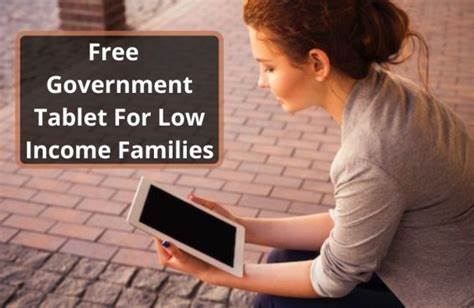Technology
Get free government tablet for low-income families 2023

Government Programs:
Several government programs offer free or low-cost tablets to eligible low-income families. The Federal Communication Commission’s (FCC) Lifeline program, which offers discounts on internet services, also provides free smartphones and tablets to qualified applicants.
The Department of Veterans Affairs provides free tablets to eligible veterans as part of their healthcare benefits. The Department of Education’s TRIO program also offers support to individuals from disadvantaged backgrounds, including low-income families. This program provides resources for academic and career development, including providing tablets to students who require them.
Non-Profit Organisations:
Many non-profit organisations offer free tablets to low-income families. One such organisation is the National Cristina Foundation, which connects individuals with disabilities, students, and veterans with technology equipment and training. Another organisation that provides free tablets is PCs for People. This organisation offers refurbished tablets at a low cost or for free to families who meet their eligibility criteria.
Local Resources:
Low-income families can also seek out local resources for free tablets. Public libraries and community centres often provide access to computers and may offer loaner tablets for short-term use.
Several government programs, non-profit organisations, and local resources provide free tablets to low-income families. It is crucial to research and explore all available options to determine the best fit for your specific situation. We encourage you to take advantage of these resources to gain access to technology that can help you achieve academic and career success.
Government Programs:
Several government programs offer free or low-cost tablets to eligible low-income families. The Federal Communication Commission’s (FCC) Lifeline program, which offers discounts on internet services, also provides free smartphones and tablets to qualified applicants. This program is aimed at making communication services affordable for low-income households. The free tablet offer is available in all states, and the Lifeline program has an eligibility criteria that applicants need to meet. The tablet offer is open to households that earn 135% of the Federal Poverty Guidelines.
Another government program that offers free tablets to eligible low-income families is the Department of Veterans Affairs. As part of their healthcare benefits, the department provides free tablets to veterans who meet certain criteria. The tablet comes pre-installed with a range of healthcare applications and is intended to provide veterans with easy access to healthcare services.
The Department of Education’s TRIO program also offers support to individuals from disadvantaged backgrounds, including low-income families. This program provides resources for academic and career development, including providing tablets to students who require them. The TRIO program focuses on helping students from low-income households, first-generation college students, and students with disabilities. Students enrolled in the program receive academic and career counselling, tutorial services, and assistance in applying for financial aid. The program provides free tablets to students who require them to complete their coursework.
Non-Profit Organisations:
Many non-profit organisations offer free tablets to low-income families. One such organisation is the National Cristina Foundation, which connects individuals with disabilities, students, and veterans with technology equipment and training. This organisation provides refurbished tablets to families who meet their eligibility criteria, such as having a household income that is below the poverty line. Additionally, the National Cristina Foundation offers training and support to help families make the most of their tablets.
Another organisation that provides free tablets is PCs for People. This organisation offers refurbished tablets at a low cost or for free to families who meet their eligibility criteria. The organisation’s aim is to bridge the digital divide and help low-income families access technology. PCs for People offers a range of tablets, including those with large screens, for individuals who are visually impaired.
Local Resources:
Low-income families can also seek out local resources for free tablets. Public libraries and community centres often provide access to computers and may offer loaner tablets for short-term use. Many libraries have programs that allow patrons to borrow tablets for up to two weeks, providing a temporary solution for individuals who do not have access to a tablet at home. Community centres may also offer loaner tablets, which can be used on-site.
Conclusion:
In conclusion, several government programs, non-profit organisations, and local resources provide free tablets to low-income families. It is crucial to research and explore all available options to determine the best fit for your specific situation. We encourage you to take advantage of these resources to gain access to technology that can help you achieve academic and career success. Having access to a tablet can make a significant difference in a person’s life, and we hope this information has been helpful to you.
-

 Business6 days ago
Business6 days agoS&P 500 Soars in Best May in Decades Amid Tariff Relief and Nvidia’s Surge
-

 Immigration6 days ago
Immigration6 days agoTrump’s Immigration Crackdown: Legal Battles and Policy Shifts
-

 Business5 days ago
Business5 days agoUS Stock Market Soars in May Amidst Tariff Tensions and Inflation Worries
-

 Government6 days ago
Government6 days agoTrump Administration’s Government Reshaping Efforts Face Criticism and Legal Battles
-

 Business6 days ago
Business6 days agoTrump’s Tariffs: A Global Economic Reckoning
-

 Foreign Policy3 days ago
Foreign Policy3 days agoInside Schedule F: Will Trump’s Federal Workforce Shake-Up Undermine Democracy?
-

 Press Release3 days ago
Press Release3 days agoIn2space Launches Campaign to Make Space Travel Accessible for All











